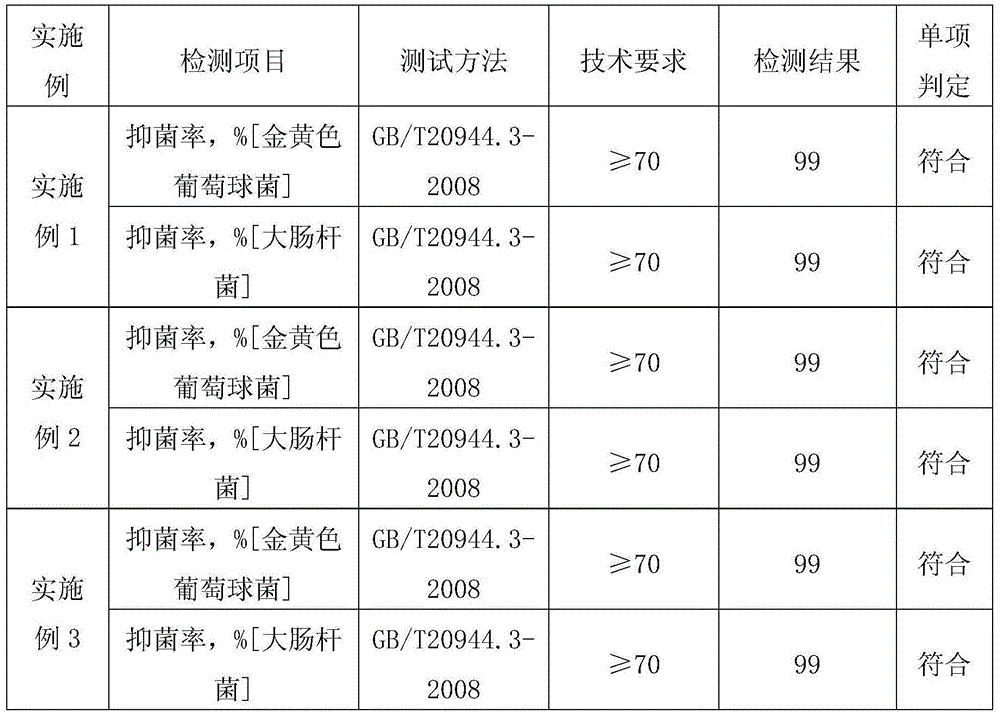Environment-friendly antibacterial composite material and manufacturing method thereof
A composite material and environment-friendly technology, which is applied in non-woven fabrics, textiles, papermaking, fiber treatment, etc., can solve the problems of low proportion of negative oxygen ions added, affect the health of the foot skin, and the actual effect is not ideal, so as to achieve adsorption Obvious odor function, fast moisture absorption and perspiration, satisfying antibacterial and odor absorption effects
- Summary
- Abstract
- Description
- Claims
- Application Information
AI Technical Summary
Problems solved by technology
Method used
Image
Examples
Embodiment 1
[0038] Using 40wt% fineness of 2.0D reinforced recycled polyester staple fiber with a length of 51mm and 35wt% fineness of 2.5D reinforced recycled polyester staple fiber with a length of 64mm and 25wt% fineness of 2.0D bamboo pulp with a length of 51mm The mixed raw materials of fibers are made by mixing, opening, carding, web forming, web laying, acupuncture, heat setting, winding, post-finishing impregnation, and tenter setting.
[0039] In the present embodiment, the specific steps of the preparation method of the antibacterial composite material are:
[0040] ①Opening: 40wt% fiber fineness of 2.0D polyester staple fiber with a length of 51mm and 35wt% fiber fineness of 2.5D polyester staple fiber with a length of 64mm and 25wt% fineness of 2.0D and a length of 51mm bamboo The mixed fibers of the pulp fibers are fed into the opener to make them fluffy to the greatest extent and mixed together evenly.
[0041] ② Feed the mixture of 2.0D reinforced recycled polyester staple...
Embodiment 2
[0049] Using 40wt% fineness of 2.0D reinforced recycled polyester staple fiber with a length of 51mm and 25wt% fineness of 2.5D reinforced recycled polyester staple fiber with a length of 64mm and 35wt% fineness of 2.0D bamboo pulp with a length of 51mm The mixed raw materials of fibers are made by mixing, opening, carding, web forming, web laying, acupuncture, heat setting, winding, post-finishing impregnation, and tenter setting.
[0050] In the present embodiment, the specific steps of the preparation method of the antibacterial composite material are:
[0051] ①Opening: 45wt% fiber fineness is 2.0D, the length is 51mm polyester staple fiber and 20wt% fiber fineness is 2.5D, length is 64mm polyester staple fiber and 35wt% fineness 2.0D, length is 51mm bamboo The mixed fibers of the pulp fibers are fed into the opener to make them fluffy to the greatest extent and mixed together evenly.
[0052] ② Feed the mixture of 2.0D reinforced recycled polyester staple fiber, 2.5D rei...
Embodiment 3
[0060] Using 40wt% fineness of 2.0D reinforced recycled polyester staple fiber with a length of 51mm and 30wt% fineness of 2.5D reinforced recycled polyester staple fiber with a length of 64mm and 30wt% fineness of 2.0D bamboo pulp with a length of 51mm The mixed raw materials of fibers are made by mixing, opening, carding, web forming, web laying, acupuncture, heat setting, winding, post-finishing impregnation, and tenter setting.
[0061] In the present embodiment, the specific steps of the preparation method of the antibacterial composite material are:
[0062] ①Opening: 40wt% fiber fineness of 2.0D polyester staple fiber with a length of 51mm and 30wt% fiber fineness of 2.5D polyester staple fiber with a length of 64mm and 30wt% fiber fineness of 2.0D and a length of 51mm bamboo The mixed fibers of the pulp fibers are fed into the opener to make them fluffy to the greatest extent and mixed together evenly.
[0063] ② Feed the mixture of 2.0D reinforced recycled polyester ...
PUM
| Property | Measurement | Unit |
|---|---|---|
| length | aaaaa | aaaaa |
| length | aaaaa | aaaaa |
Abstract
Description
Claims
Application Information
 Login to View More
Login to View More - Generate Ideas
- Intellectual Property
- Life Sciences
- Materials
- Tech Scout
- Unparalleled Data Quality
- Higher Quality Content
- 60% Fewer Hallucinations
Browse by: Latest US Patents, China's latest patents, Technical Efficacy Thesaurus, Application Domain, Technology Topic, Popular Technical Reports.
© 2025 PatSnap. All rights reserved.Legal|Privacy policy|Modern Slavery Act Transparency Statement|Sitemap|About US| Contact US: help@patsnap.com

